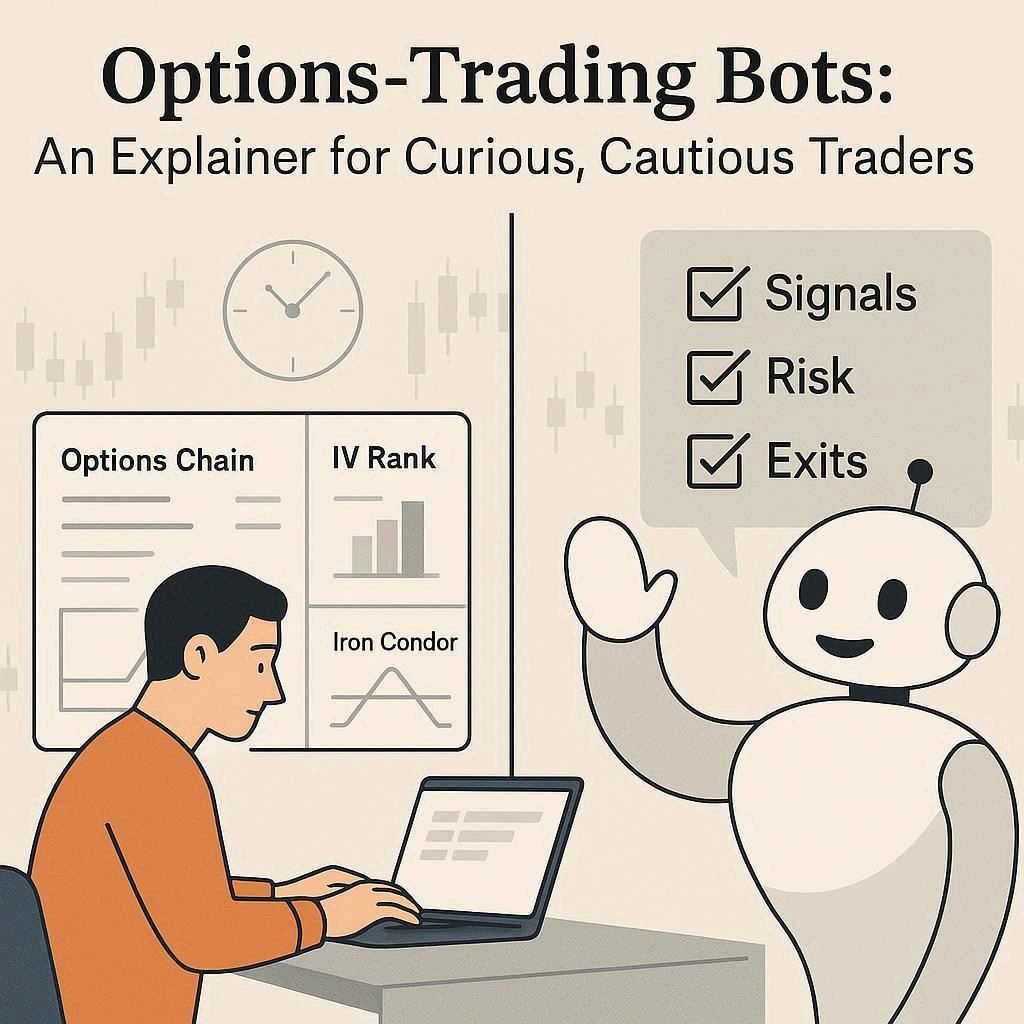Algorithmic tools have long powered institutional options desks. In recent years, retail traders have gained access to simplified automation—“options bots”—that can scan markets, place orders, and manage positions according to pre-set rules. This post explains what these bots do, how they’re structured, the trade-offs involved, and when (if ever) they make sense. It’s an overview, not a pitch—and it includes a checklist to help you assess fit.
What is an options bot?
An option bot is software that executes an options strategy based on rules you configure. Think of it as a tireless assistant: it doesn’t “predict” the market; it enforces your plan with speed and consistency. Typical tasks include scanning for signals (volatility shifts, moving-average crosses, skew changes), placing entries (spreads, covered calls, iron condors), and managing exits (profit targets, time-based closes, or delta/theta thresholds).
Core building blocks
-
Signals & filters. Indicators, earnings calendars, IV rank, time to expiration (DTE), liquidity screens, and position limits. Good bots let you combine filters (e.g., IVR > 30, bid-ask spread < 5%).
-
Strategy templates. Common structures like verticals, calendars, and iron condors, with parameters for strikes (delta bands), width, DTE, and max capital per trade.
-
Risk management. Hard stops, soft exits, scaling rules, and global circuit breakers that pause trading after a daily loss or series of losers.
-
Order routing & fills. Market, limit, or conditional orders. Fill logic matters: chasing fills can erode edge; too strict and you miss trades.
-
Monitoring & logs. Time-stamped decisions, P/L attribution, slippage reports, and alerting. Without this, you can’t improve the system.
What bots are good at (and not)
Strengths
-
Consistency: rules do not panic or revenge-trade.
-
Throughput: scanning dozens of tickers and expiries is arduous manually.
-
Discipline: pre-committed exits prevent “just one more roll.”
Limits
-
Garbage in, garbage out: poor rules are executed perfectly—and lose perfectly.
-
Regime sensitivity: IV crush after earnings, macro shocks, and liquidity droughts can break assumptions.
-
Slippage & fees: frequent multileg orders can turn theoretical edge into break-even in practice.
Popular use cases
-
Income strategies: systematic short premium (e.g., 30–45 DTE, 10–20 delta spreads) with strict risk caps.
-
Event plays: pre-earnings long straddles or post-event theta capture with tight time stops.
-
Hedging: automated put rolls that trigger when portfolio delta exceeds a threshold.
-
Time management: traders with a day job who want rule-based execution, not screens all day.
Myths vs. reality
-
Myth: Bots find secret edges.
Reality: They enforce edges you define and test. The “secret” is rigorous research and risk control. -
Myth: More trades = more profits.
Reality: Position sizing and costs dominate. Sometimes fewer, higher-quality setups win. -
Myth: Backtests guarantee results.
Reality: They reveal fragility. Walk-forward testing and out-of-sample periods matter more than perfect historical curves.
Minimum viable process
-
Define the hypothesis: e.g., “Short 15-delta iron condors perform well when IVR > 25 and trend is neutral.”
-
Backtest responsibly: include realistic slippage, commissions, and missed fills; test multiple regimes (calm and crisis).
-
Start tiny live: smallest size, observe fills and alerts, verify risk stops trigger as expected.
-
Measure and iterate: track win rate, average win/loss, max drawdown, and volatility of returns.
-
Codify risk first: portfolio-level limits (per-day loss, per-strategy exposure) before optimizing entries.
Who might benefit?
-
Process-oriented traders who already journal and respect risk.
-
Data-curious investors willing to test and refine rather than “set and forget.”
-
Time-constrained professionals seeking consistency over spontaneity.
Red flags to watch
-
“Guaranteed returns” or unverified performance claims.
-
Opaque fill logic, no logs, or no kill switch.
-
Inability to simulate with realistic costs.
-
Pressure to scale quickly without risk caps.
Bottom line
Options bots are power tools. Used thoughtfully—with clear hypotheses, tight risk controls, and humility about regime shifts—they can bring discipline and scale to an options playbook. Used carelessly, they just automate mistakes. Start small, measure obsessively, and let data—not hope—decide what remains in production.





